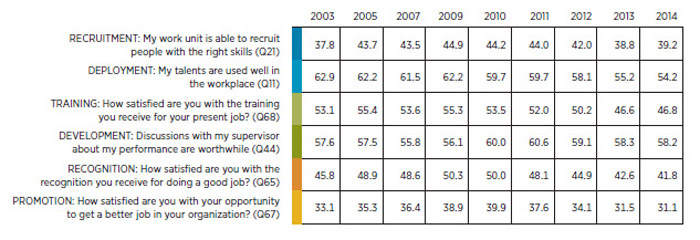Increased employee satisfaction benefits recruitment, retention
New analysis from the Partnership for Public Service of the Office of Personnel Management's Employee Viewpoint Survey shows that low employee satisfaction nega...
Federal agencies are finding it increasingly more difficult to recruit and retain younger employees. That’s according to a new analysis by the Partnership for Public Service of the Office of Personnel Management’s Federal Employee Viewpoint Survey results.
Between 2010 and 2015, the percentage of federal employees under the age of 30 declined from 9.1 percent to 6.6 percent, which equates to a reduction of more than 45,000 employees. In the same period, the percentage of feds under the age of 25 dropped from 2 percent to 0.92 percent.
Percent of employees under age 30 and under age 25

The partnership’s report, entitled Improving the Employee Experience, credits low employee satisfaction as one of the key factors working against agencies when it comes to recruitment and retention.
After the first year of federal service, the satisfaction rate among federal employees drops from 72.3 points to 62.5 points on a 100-point scale, according to EVA data and results of the partnership’s Best Places to Work in Federal Government report.
The partnership’s analysis contends that by focusing on key phases in the talent life cycle, federal managers can improve employee satisfaction. Those key phases are: Recruitment, Deployment, Training, Development, Recognition and Promotion.
“In 2014, 60.2 percent of federal employees would be willing to recommend their agency as a good place to work,” the report said. “With improvements at each stage in the life cycle, federal agencies can drive that number higher.”
Percent of positive responses on talent management over time

Management solutions for key talent lifecycle phases
The partnership’s report offers a number of solutions for managers on how they can improve employee satisfaction at the key phases in their employees’ careers. The following is a summary of the problems encountered at each phase and possible solutions.
Recruitment – “In 2014, only 39.2 percent of the federal employee survey respondents said their teams can attract the right people,” the report said.
Solutions: Managers should communicate a compelling vision of the agency’s mission, connecting on a personal level with new hires.
One way to recruit and retain younger employees is to take advantage of the Pathways Program, which helps develop future leaders through its internship and recent graduates programs. It also offers the Presidential Management Fellows Program, bringing individuals with advanced degrees into federal service.
Deployment – “On the question, ‘My talents are used well in the workplace,’ scores have fallen by 8.7 points to 54.2 percent from the peak in 2003,” the report said. “When employees do not feel like they are being effectively utilized, morale and productivity suffer.”
Solutions: Managers should talk to employees about their interests and how they can best use their skills in meeting the agency’s mission. This may mean changing an employee’s assignment or adding new responsibilities.
Training – Of the federal employees surveyed in 2014, only 46.8 percent said they were satisfied with the training they were receiving on the job. This is 8.6 points lower than in 2005.
Solutions: Managers should increase the time they spend talking to and giving advice to their employees. They should also increase the number of training opportunities they identify for their employees.
Development – Managers play an important role in helping to develop an employee’s talent and making sure they remain productive. “Federal employee survey results for the question, ‘Discussions
with my supervisor about my performance are worthwhile,’ have hovered around 58 percent for the
past decade, which is somewhat encouraging compared to other aspects of the talent lifecycle, but it is still a failing grade,” the report said.
Solutions: Managers should “be a coach” to their employees, encouraging them and helping them through the challenges they face.
Recognition – “In 2014, only 41.8 percent of employees were satisfied with the recognition they received for doing a good job, which represents a decrease of 8.5 points from the highest level in 2009,” the report said.
Solutions: The personal touch goes a long way when it comes to employee recognition. Managers should thank employees for good work and share their accomplishments with others. A simple, handwritten note means a lot.
Promotion – “Less than one-third (31.1 percent) of the federal survey respondents … were satisfied with opportunities to get a better job in their organizations in 2014,” the report said. “This figure has dropped 8.8 points since the peak score in 2010.”
Solutions: Managers should provide realistic feedback with employees to help them advance in their careers. They should also be helpful to employees as they move into a new job or join another organization.
Copyright © 2024 Federal News Network. All rights reserved. This website is not intended for users located within the European Economic Area.
Michael O’Connell is senior digital editor of Federal News Network optimizing content for the best user experience. Follow @moconnellWFED
Follow @moconnellWFED



